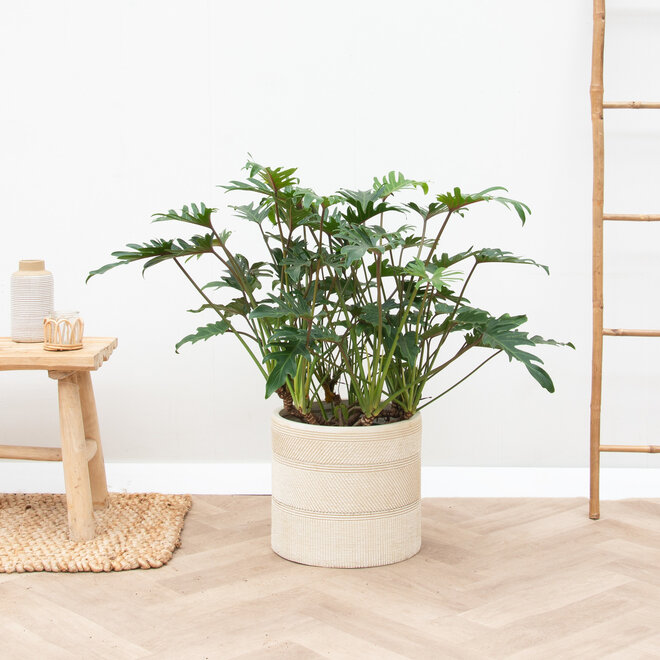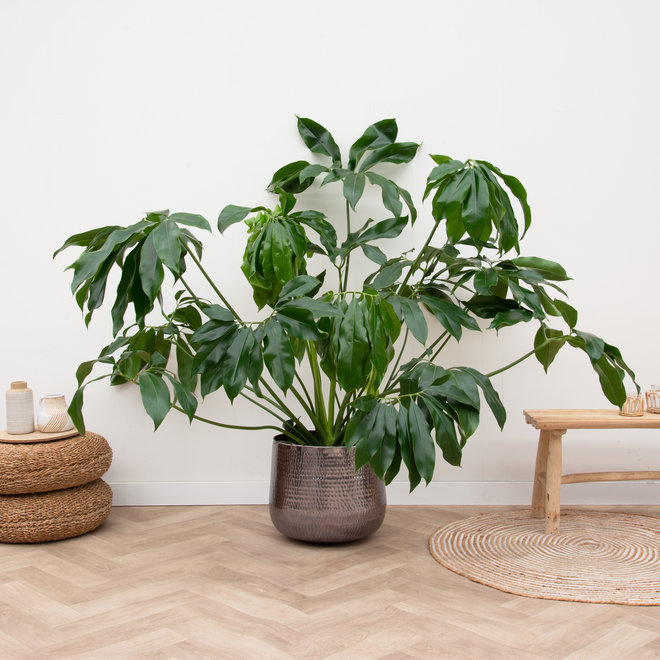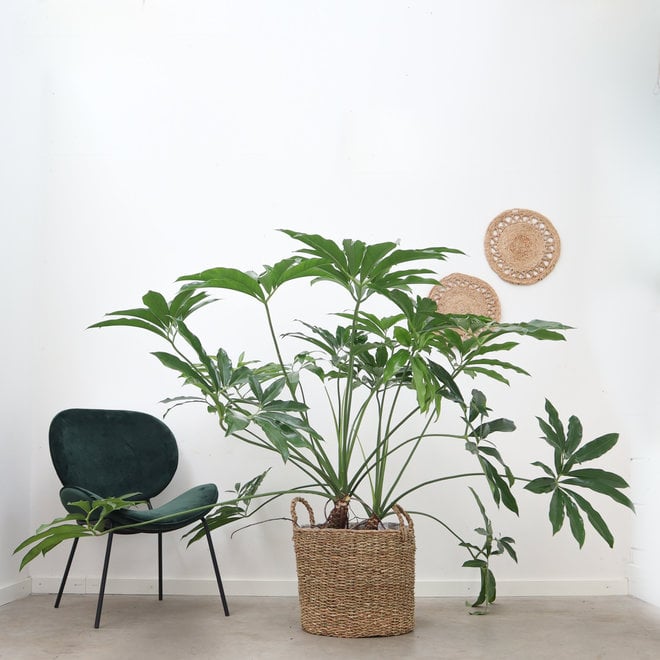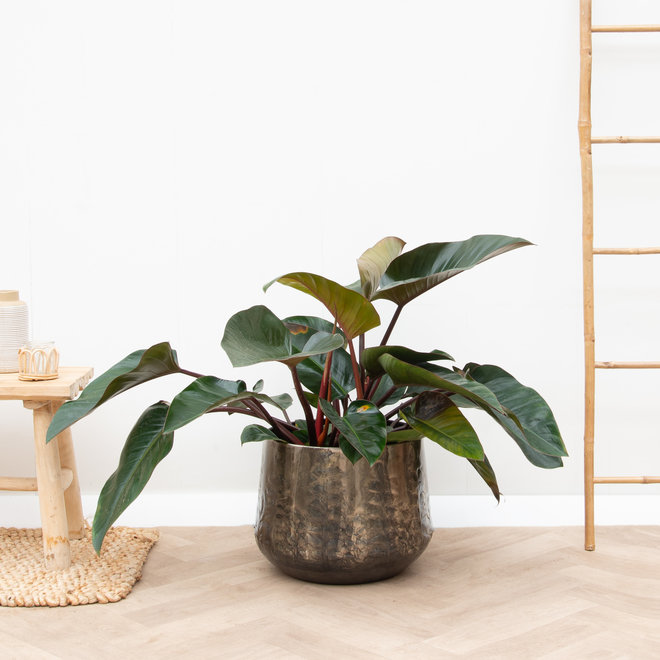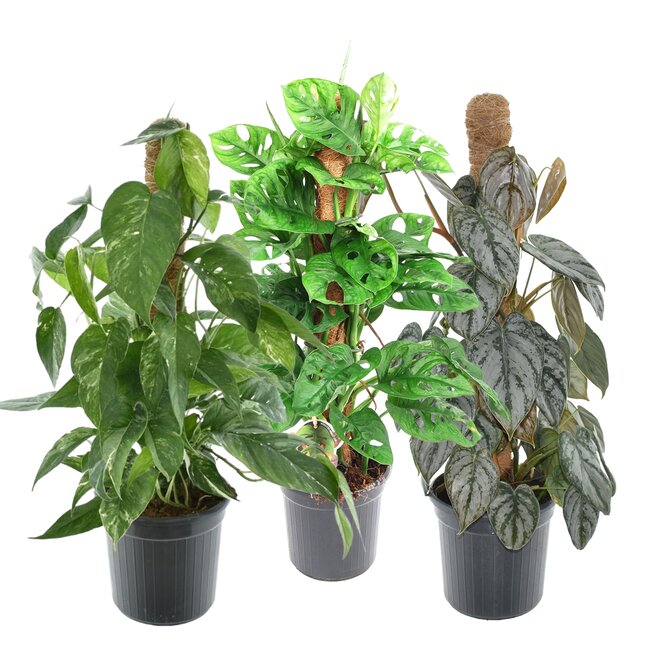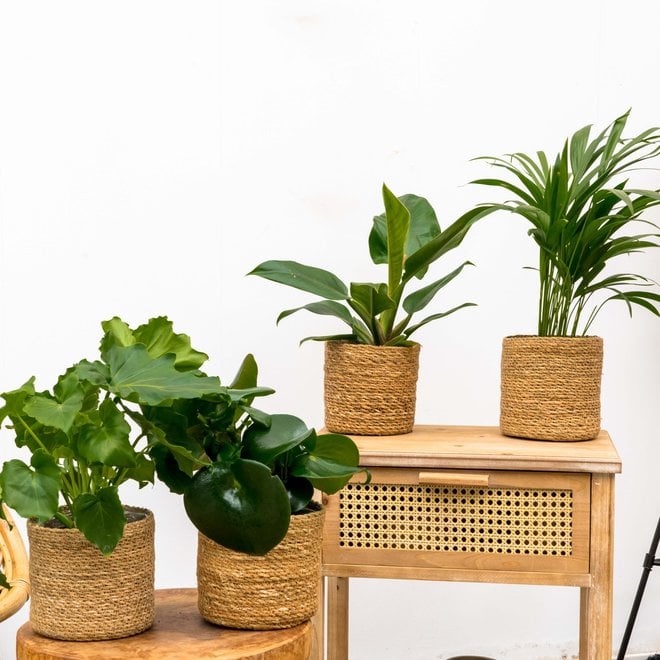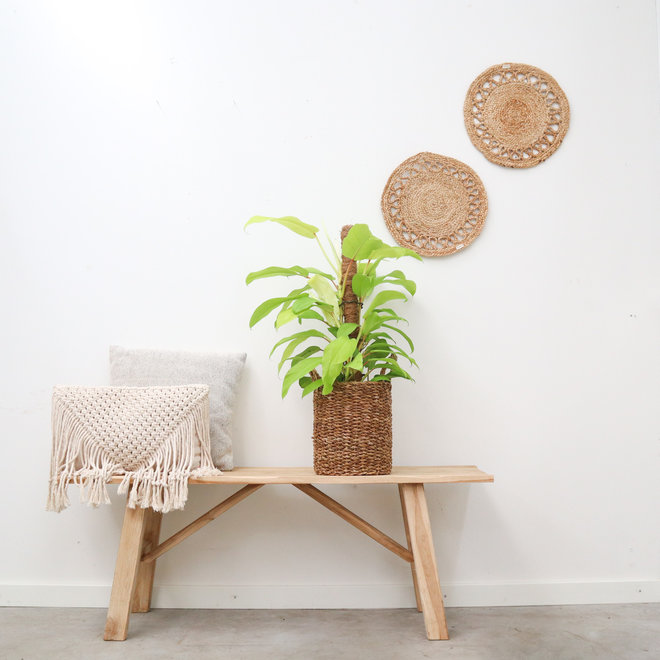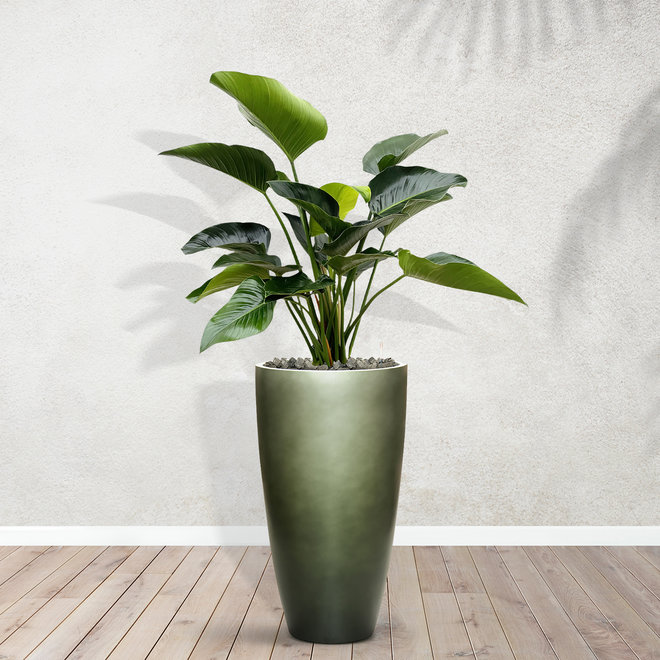The Philondendron originates from the rainforests of South America and belongs to the arum family. There are more than 500 different species, most of which, in appearance, cannot be compared with each other. The Arum family is divided into two parts namely, the climbing plants and the non-climbing plants. The climbing air-purifying plants form aerial roots with which they climb up along the trunks of the trees in the Jungles. On the ground of the Jungles there is little sun and in this way the plant tries to get the necessary light. The roots meander around the trees which almost looks like a loving embrace. This is also where the Philodendron plant got its name from. Philodendron is a Greek name and has a very nice translation into Dutch. 'Philo' means love and/or passion and 'Dendron' is the Greek name for tree. The Dutch translation would be freely translated so love for the tree.
The Philodendron varieties are popular but also easy to care for houseplants . In the Netherlands there are a number of very popular houseplants that are also for sale at Green Bubble!
Water requirements of the Philodendron The water requirement of the Philodendron houseplant depends on the location and the size of the houseplant. Therefore, always check in the beginning with the amount and frequency of watering.
In spring and summer, the soil in which this houseplant is placed should always be moist. This houseplant generally does not consume much water. For Philodendron care you have to make sure that you do not give the plant too much water, a Philodendron plant is sensitive to this. As soon as the soil starts to dry, you can give the houseplant some new water. In the winter months, the soil may feel a bit drier for a week before you water the houseplant again.
Feel the soil regularly (especially in the beginning) to see if the soil is still moist enough. After a few weeks you feel how much water your Philodendron plant needs.
Spraying the Philodendron plant It is good for this houseplant to be sprayed with some regularity, so we advise you to do this. The climbing specimens are even happier with this than the standing ones. We recommend that you spray these houseplants once a week. If you care for a Philodendron, spraying can ensure that the dust is removed from the leaves, and the sunlight can reach the Philodendron plant better. It also helps in the preventive prevention of pests.
The best location for the Philodendron houseplant This houseplant is not the most difficult in terms of its location, however, the perfect location differs per family member. In general, these houseplants do well in a place without direct sunlight and especially the bright sunlight in the afternoon hours. A spot near a north-facing window is always good for this houseplant. However, it is important that he gets enough daylight, about 3 to 5 hours a day. We recommend that you turn this houseplant regularly so that it does not grow to one side.
Due to its tropical origin, this houseplant can not withstand cold well. The minimum temperature during the day is 15 degrees and the minimum temperature at night is 12 degrees. So keep this in mind.
Help! The leaves of my Philodendron are discolouring Incorrect care of your Philodendron can cause discoloration of the houseplant. If the outer leaves turn brown, this is because the houseplant makes room for new leaves. These outer leaves are then repelled. If many leaves discolor at once, there is usually something else going on.
When the leaves get brown or yellow edges, this is often due to a surplus of water. In this case, water the Philodendron plant less often and in smaller amounts. We also recommend checking the soil more often. The leaves of this houseplant can also become yellowish and droop. In most cases, this is due to too much direct sunlight. We recommend that you move the Philodendron to a less sunny place.
Pruning the Philodenron houseplant Is your Philodendron plant getting a little too big? Don't panic, these houseplants are easy to trim / prune where necessary. The climbing variants will always climb along the moss stick or the mesh rack , so these variants will stay nicely in shape. However, the standing variants can get offshoots to places you don't want. You can safely cut off these suckers with scissors. Cut this stem off at the run-off point. Old leaves and stems can also easily be cut off, the Philodendron repairs itself.
The flowering of the Philodenron Indoors, this houseplant will almost never bloom, however, there are always outliers. If your houseplant is in bloom, we advise you to cut off the flowers anyway. The smell of these flowers is often not pleasant. The flowering also costs this houseplant a lot of energy this energy can better stop the Philodendron plant in the growth and its roots. This makes the plant stronger!
Is the Philodendron a poisonous houseplant? Many houseplants are poisonous, so it is good to take a look at this. Most species of the Philodendron are poisonous when ingested. So make sure that pets and small children do not start chewing on the leaves. We advise you to put this houseplant in a place where the smaller among us can not easily reach it. Taking the Philodenron can be toxic to the kidneys.
Common diseases in the Philodendron In general, this easy-to-maintain houseplant does not suffer much from pests. Especially the variants with a somewhat harder leaf are not sensitive to this. Nevertheless, it can always occur. When your houseplant suffers from mealybugs, it is best to take immediate action. Spray the plant and remove as many pests as possible with a wet cloth. Next, it is advisable to control your houseplant with a biological or chemical pesticide.
Repotting the Philodendron houseplant Your philodendron naturally grows fast due to the good care it receives, so it may be time for a new pot (this is different for each variant). We recommend repotting the Philodendron plant in the spring. At this time of year, this houseplant has the most energy to strengthen any damaged roots. Spring is the beginning of its growing period. Keep in mind that the new pot is 20% larger than its predecessor. We recommend that you repot the Philodendron plant once every two years. What also stimulates the growth of this houseplant is to replace the loose top layer of potting soil with fresh soil. This soil contains new nutrients on which the houseplant can live again for a while.
Propagating the Philodendron The way and ease of propagation differs per species. Climbing varieties are easiest to propagate. Cut off a piece of stem with aerial root and put it in the water. This cutting must have at least two balls. The trunk and leaves should not be in the water.
The non-climbing variants are a bit more difficult to propagate. You can propagate them by means of seeds or small plants that grow next to the large plant.
These cuttings often do best at a temperature of around 23 degrees. This is a high temperature for the living room. In order for the cutting to survive, we advise you to put a plastic bag over the plant. The humidity and temperature will rise as a result, which increases the chance of survival.
Giving the Philodendron extra nutrition Spring and summer are the growing period of this houseplant. If you want to give your Philodendron plant just a little extra strength, we advise you to give the extra nutrition at this time of year. General indoor plant food is also suitable for the Philodendron, but never give more or more often than recommended. The soil becomes acidic from this food and this can seriously affect the roots of the Philodendron plant. Never give the Philodendron extra food in the winter months. In these months, the houseplant is at rest and extra nutrition can then cause damage.
Philodendron species There are hundreds of different Philodendron varieties available. In our assortment we have added a wide range so that you can obtain the right plant! One of the most popular Philodendron species is the Philodendron Scandens , this plant is often purchased as a potted plant, but also as a hanging plant! Another popular Philodendron species is the Philodendron Xanadu . This houseplant looks slightly different, since the leaves have a different shape. There are many more Philodendron plant species, so take a look at our assortment to see if there is something for you!
Buy a Philodendron at Green Bubble Are you looking for a beautiful and healthy Philodendron as a houseplant? Then you've come to the right place at Green Bubble! The moment you buy one of our palm varieties, you naturally want a beautiful and fresh plant. At Green Bubble we work directly with growers so that we can guarantee the freshness of our houseplants. We strive to deliver healthy and high-quality plants to our customers every day. This way you will get your houseplant delivered as fresh and as well as possible!
Do you want to buy a Philodendron but don't feel like going to the local garden store? We understand that, that's why we send your Philodendron plant directly to you and that for free! You can easily buy a Philodendron in our webshop where you can buy different types of Philodendrons of the highest quality!
Ease of ordering and cool houseplants, that's what Green Bubble stands for. Do you want to buy a crazy Philodendron? Join the Green Bubble!


